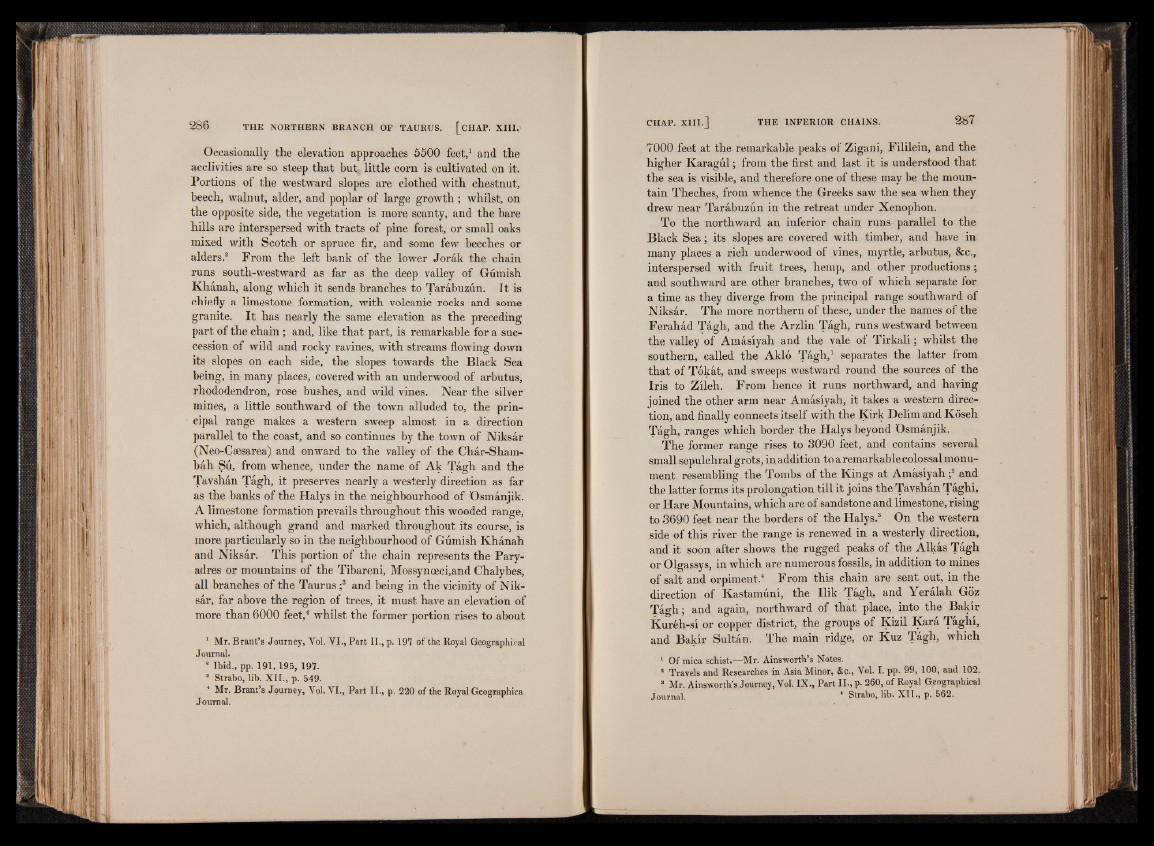
Occasionally the elevation approaches 5500 feet,1 and the
acclivities are so steep that but little corn is cultivated on it.
Portions of the westward slopes are clothed with chestnut,
beech, walnut, alder, and poplar of large growth; whilst, on
the opposite side, the vegetation is more scanty, and the bare
hills are interspersed with tracts of pine forest, or small oaks
mixed with Scotch or spruce fir, and some few beeches or
alders.2 From the left bank of the lower Jorak the chain
runs south-westward as far as the deep valley of Gumish
Khanah, along which it sends branches to Tarabuzun. It is
chiefly a limestone formation, with volcanic rocks and some
granite. It has nearly the same elevation as the preceding
part of the chain; and, like that part, is remarkable for a succession
of wild and rocky ravines, with streams flowing down
its slopes on each side, the slopes towards the Black Sea
being, in many places, covered with an underwood of arbutus,
rhododendron, rose hushes, and wild vines. Near the silver
mines, a little southward of the town alluded to, the principal
range makes a western sweep almost in a direction
parallel to the eoast, and so continues by the town of Niksar
(Neo-Csesarea) and onward to the valley of the Char-Sham-
bah Su, from whence, under the name of Ak Tagh and the
Tavshan Tagh, it preserves nearly a westerly direction as far
as the banks of the Halys in the neighbourhood of ’Osmanjik.
A limestone formation prevails throughout this wooded range,
which, although grand and marked throughout its course, is
more particularly so in the neighbourhood of Gumish Khanah
and Niksar. This portion of the chain represents the Pary-
adres or mountains of the Tibareni, Mossynoeci,and Chalybes,
all branches of the Taurus ;3 and being in the vicinity of Niksar,
far above the region of trees, it must have an elevation of
more than 6000 feet,4 whilst the former portion rises to about
1 Mr. Brant’s Journey, Vol. VI., Part II., p. 197 of the Royal Geographical
Journal.
2 Ibid., pp. 191,195, 197.
8 Strabo, lib. XII., p. 549.
1 Mr. Brant’s Journey, Vol. VI., Part II., p. 220 of the Royal Geographies
Journal.
7000 feet at the remarkable peaks of Zigani, Fililein, and the
higher Karagul; from the first and last it is understood that
the sea is visible, and therefore one of these may be the mountain
Theches, from whence the Greeks saw the sea when they
drew near Tarabuzun in the retreat under Xenophon.
To the northward an inferior chain runs- parallel to the
Black Sea; its slopes are covered with timber, and have in
many places a rich underwood of vines, myrtle, arbutus, &c.,
interspersed with fruit trees, hemp, and other productions;
and southward are other branches, two of which separate for
a time as they diverge from the principal range southward of
Niksar. The more northern of these, under the names of the
Ferahad Tagh, and the Arzlin Tagh, runs westward between
the valley of Amasiyah and the vale of Tirkali; whilst the
southern, called the Aklo Tagh,1 separates the latter from
that of Tokat, and sweeps westward round the sources of the
Iris to Zileh. From hence it runs northward, and having
joined the other arm near Amasiyah, it takes a western direction,
and finally connects itself with the Kirk Delim and Koseh
Tagh, ranges which border the Halys beyond Osmanjik.
The former range rises to 3090 feet, and contains several
small sepulchral grots, in addition to a remarkable colossal monument
resembling the Tombs of the Kings at Amasiyah ;2 and
the latter forms its prolongation till it joins the Tavshan Taghi,
or Hare Mountains, which are of sandstone and limestone, rising
to 3690 feet near the borders of the Halys.3 On the western
side of this river the range is renewed in a westerly direction,
and it soon after shows the rugged peaks of the Alkas Tagh
or Olgassys, in which are numerous fossils, in addition to mines
of salt and orpiment.4 From this chain are sent out, in the
direction of Kastamuni, the Ilik Tagh, and Yeralah Goz
Tagh; and again, northward of that place, into the Bakir
Kurhh-si or copper district, the groups of Kizil Kara Taghi,
and Bakir Sultan. The main ridge, or Kuz Tagh, which
1 Of mica schist.—Mr. Ainsworth’s Notes.
2 Travels and Researches in Asia Minor, &c., Vol. I. pp. 99, 100, and 102.
3 Mr. Ainsworth's Journey, Vol. IX., Part II., p. 260, of Royal Geographical
journal. 4 Strabo, lib. XII., p. 562.